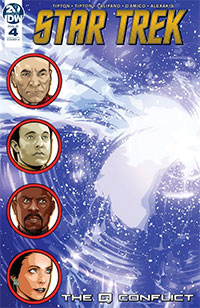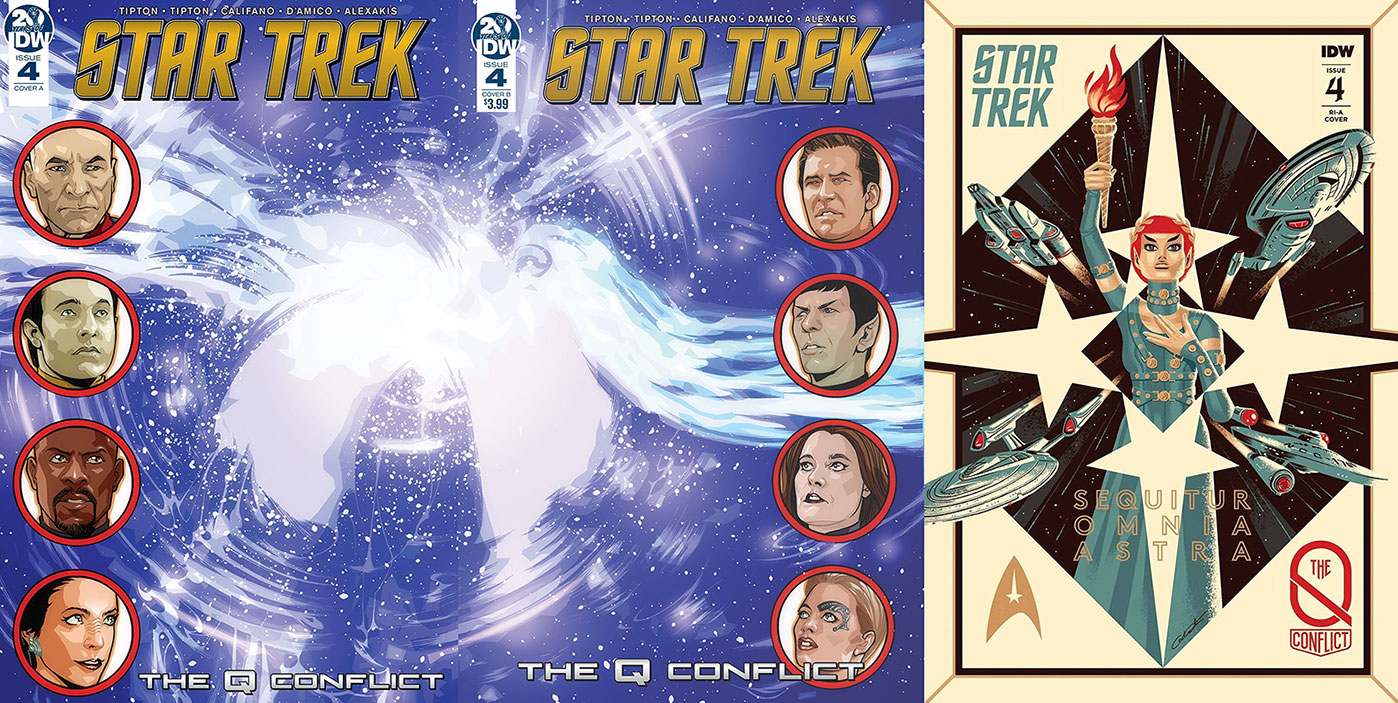I believe good storytelling depends on characters. Knowing how characters will behave in given situations creates believable dialogue, authentic behaviour and most importantly, reader acceptance. When writing about established franchises, writers need to know their stuff.
Looking at Star Trek: The Q-Conflict #4, Scott and David Tipton have easily achieved that measure in looking at the inter-dynamic relationships among the myriad of Trek characters they have assembled for this innovative Star Trek adventure.
But before we get to the shining examples of this effect in Issue #4, let’s recap the story so far.
Threatened by the existence of Trelane, Ayelborne of the Organians, and the Metrons, Q has designed a challenge among these immortal beings to see who actually has the most power. Rather than extend the conflict through martial means and tearing the fabric of time and space apart, he has assembled four teams of Starfleet crews from various times in history.
Representing Team Q is Captain Picard, Spock, Dr. Crusher, Lieutenant Uhura, Constable Odo, Commander La Forge and Seven of Nine. For the team of Trelane, we have Captain Kirk, Worf, Quark, Miles O’Brien, Tuvok and Dax.
The Metron has on his team Captain Janeway, Commander Riker, Lieutenant Paris, Montgomery Scott, Major Kira, B’Elanna Torres and Ensign Chekov, for good measure. Ayelborne of the Organians claims Captain Sisko, Commander Chakotay, Lieutenant Sulu, Commander Data, Doctor Bashir, Deanna Troi and Ensign Kim.
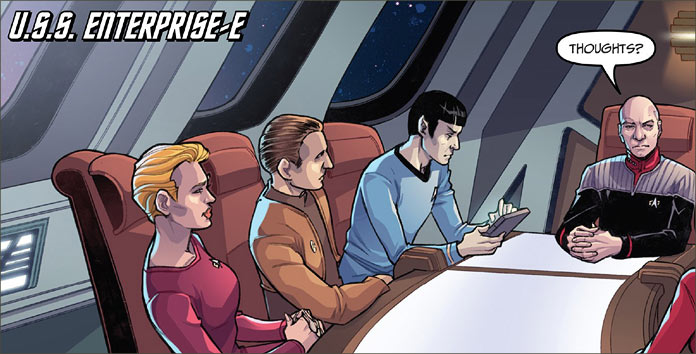
In his infinite capacity for annoyance, Q has decided that the Bajoran Prophets are to be the subjects of his next challenge for the different crews. There is a wonderful scene drawn by Silvia Califano that places all of the teams on the outer hull of station Deep Space 9, observing the wormhole. He tasks them with simply getting the Prophets’ attention and trusts that “Starfleet ingenuity” will allow each of the teams to accomplish this task admirably. Of course, all of the crews have their own unique ways of doing that.
But even before this begins, there is a true-to-art interaction between Captain Picard and Guinan, who gives Picard the benefit of her own unique near-immortal perception. She knows Q very well and provides him with the notion that he may have more allies than he realizes and that Q may have over-taxed himself this time. This is a completely accurate character trait of Picard. A thoughtful captain, there are at least five episodes of The Next Generation that I can think of where Guinan’s wisdom was completely useful, and especially in their encounters with Q.
First of all, it’s to the Tiptons’ credit that they have such detailed familiarity with the character how to weave her presence into this story so well. It’s applicable, effective and provides the story with a degree of authenticity that Next Generation fans would see immediately and accept.
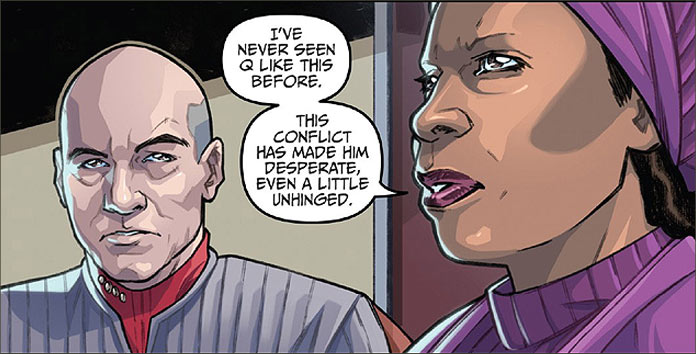
Second, it not only expertly resonates Guinan’s character with the reading audience but her presence also reinforces and validate both Q and Picard in this story. Q despises Guinan; thus, having her in this story not only adds verisimilitude to the story but an excellent pivot point in the plot for the crews to turn the tables on Q. The addition of this one character basically augments the entire story.
The Tiptons’ knowledge of these characters can even be seen in the crews’ methods of contacting the Prophets. Sisko, as their Emissary, simply chooses a passive and respectful way of contacting them through his thoughts. As they are within proximity of the wormhole, it just naturally falls into place that they will be able to hear his attempts.
Picard decides upon a direct, yet still thoughtful way of communicating with the Prophets. Flooding the wormhole with tachyons should be enough to get their attention but not forceful enough to be considered an attack.
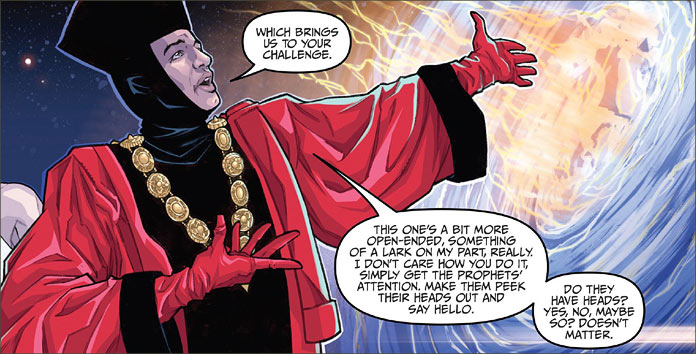
Captain Janeway’s methodology is a bit simpler. Taking stock of the resources she has, she visits Deep Space 9 and with Major Kira’s help, asks the Vedeks to help her open one of the orbs on board the station for direct contact with the Prophets. While this is also a polite method, it is totally in line with Janeway’s character to consider the simplest of options.
But then there is the boldfaced approach of James T. Kirk, surprisingly inspired by Commander Dax. The Tiptons successfully marry the characters of these two personalities so well that they complement each other ideally. As for results, well, you’ll just have to read the book and see who’s the successful team.
In terms or art, Silvia Califano does due justice to all the different characters. She achieves a highly creditable degree of excellence in pulling off likenesses but she also brings a thoroughly good degree of staging, body language and facial expressions that successfully augment the storytelling in this book.
Looking at the three covers for the book, we are treated to the work of David Messina who provides the art for covers ‘A’ and ‘B,’ which are two halves of a single image. Cover ‘A’ has the profiles of Picard, Data, Sisko and Major Kira on the left side of the book, with part of the wormhole in the background. Cover ‘B’ sees profile pictures of Kirk, Spock, Janeway and Seven of Nine on the right side of the cover with the rest of the wormhole likewise behind them.
The retailer-incentive cover by George Caltsoudas really takes the cake here. Another propaganda-style image, this one has a stylized Vulcan holding up a torch with the Latin motto “Sequitur Omnia Astra”, which means “Follow the Stars.” In the four corners of the image, each starship can be seen triumphantly soaring into adventure.
As competition is the main theme of this book, this is another example of how Caltsoudas manages to find an original image that captures the spirit of Star Trek, instead of episodic moments from the story. Caltsoudas has won me over with this one.
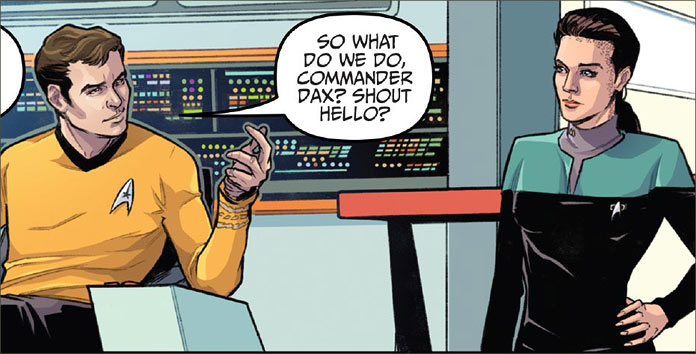
This story is an original adventure that uses Star Trek material from four versions of the continuing franchise in a way that shows that regardless of the time period, if authors, like the Tiptons, know their material, they can find new ways of presenting it to already-established audiences.
Knowing canon is essential, but knowing characters is more important. In this, Scott and David have established themselves as expert writers who can create stories that any solid fan of the franchise would expect and more importantly, enjoy.

